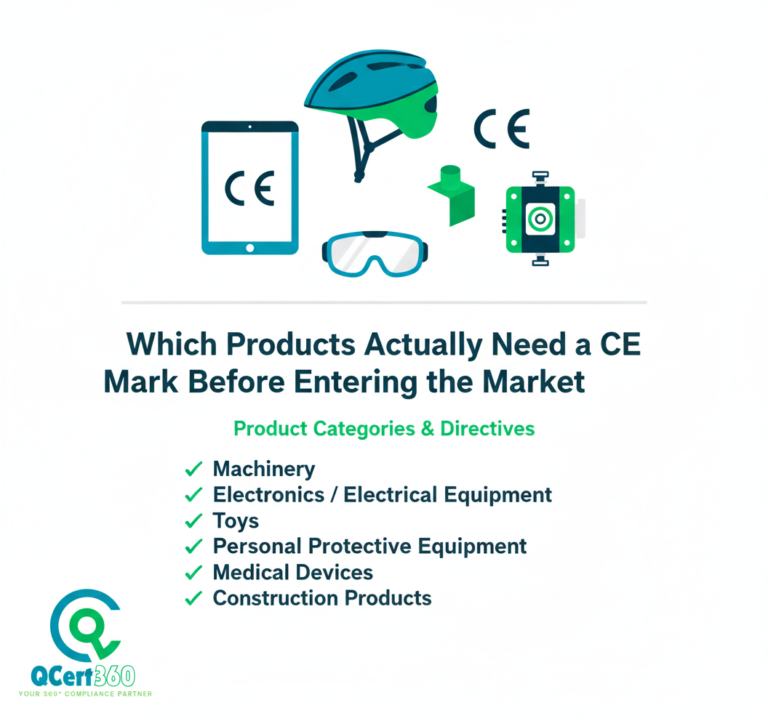
The CE mark is more than a symbol—it’s a passport into the European Economic Area. Without it, many products can’t legally be sold, distributed, or even promoted across Europe. Yet confusion persists: do all products need it, or just certain categories? The truth is, CE marking applies to specific regulated products, and understanding which ones qualify is the first step to compliance.
Let’s break down where CE marking compliance is mandatory, how industries interpret the requirements, and why getting it wrong can cost businesses time, money, and reputation.
Why CE Marking Exists in the First Place
The CE mark assures regulators, buyers, and end-users that a product meets the essential safety, health, and environmental protection standards of EU directives and regulations. It creates a level playing field, allowing products to move freely without additional testing in every country.
But here’s the catch—not everything requires CE marking. Only products covered under EU directives or regulations must bear it. That’s why a sofa or a book won’t have a CE mark, but a children’s toy or a piece of electrical equipment must.
Core Product Categories That Require CE Marking
- Electrical and Electronic Devices
Any product powered by electricity generally falls under multiple directives. Think of:
- Household appliances like washing machines or vacuum cleaners.
- IT equipment such as servers, tablets, or printers.
- Consumer gadgets from headphones to smart home devices.
These are tested against directives such as Low Voltage Directive (LVD), Electromagnetic Compatibility (EMC), and RoHS for restricted hazardous substances.
- Toys and Children’s Products
This is one of the most tightly regulated categories. Toys require compliance with the Toy Safety Directive, which covers mechanical hazards, flammability, chemical exposure, and labelling requirements.
Why so strict? Because enforcement bodies often seize counterfeit toys with unsafe paints or small detachable parts. Without CE marking, these products can’t be legally sold.
- Machinery and Industrial Equipment
From factory conveyor belts to construction cranes, machinery falls under the Machinery Directive. Manufacturers must conduct a risk assessment and ensure compliance with essential safety requirements before applying the CE mark.
Even partially completed machinery may require documentation, proving it can be safely integrated into a larger system.
- Medical Devices and In-Vitro Diagnostics
Few areas are as closely monitored as healthcare. Products like surgical tools, diagnostic machines, and implantable devices need CE marking under the Medical Devices Regulation (MDR) or In Vitro Diagnostic Regulation (IVDR).
This process often requires involvement of a Notified Body, which audits and verifies compliance before certification.
- Personal Protective Equipment (PPE)
Masks, helmets, gloves, and protective clothing all fall under the PPE Regulation. COVID-19 highlighted just how vital CE marking is here—many shipments of masks were blocked at borders because they lacked proper certification.
- Construction Products
Windows, doors, insulation materials, and structural steel require CE marking under the Construction Products Regulation (CPR). Unlike other sectors, testing is often tied to harmonized European standards for performance and durability.
- Measuring Instruments
Products like gas meters, taxi meters, and water meters need CE marking under the Measuring Instruments Directive (MID). Accuracy is crucial, since these devices often underpin billing or safety-critical systems.
- Radio and Wireless Equipment
Smartphones, Wi-Fi routers, drones, and IoT devices fall under the Radio Equipment Directive (RED). Testing ensures devices don’t interfere with networks and meet health standards for radio frequency exposure.
- Gas Appliances
Cookers, heaters, and boilers are regulated by the Gas Appliances Regulation (GAR). CE marking ensures these products meet essential safety, combustion, and energy efficiency requirements.
- Lifts and Safety Components
Passenger lifts and their critical safety parts must comply with the Lifts Directive, proving they can operate securely under load and emergency conditions.
Products That Do Not Require CE Marking
This is where many businesses get confused. Not every product on the European market carries a CE mark, and assuming it does often lead to unnecessary delays or compliance costs. Categories like:
- Furniture – Standard furniture such as tables, chairs, or cabinets is not subject to CE marking, unless it includes electrical components or falls under special safety regulations. Instead, it may need compliance with fire safety standards or BIFMA guidelines for durability.
- Clothing and textiles (unless PPE) – Everyday fashion items and textiles don’t need CE marking. However, when clothing is designed as personal protective equipment (PPE)—for example, safety jackets, helmets, or work gloves—then CE marking becomes mandatory.
- Cosmetics – Perfumes, skincare, and other cosmetic products are regulated under the EU Cosmetics Regulation and must follow strict safety and labelling rules. They are not CE marked but must comply with chemical restrictions under REACH.
- Food and beverages – These are never CE marked. Instead, they fall under EU food hygiene regulations such as HACCP and sector-specific standards to ensure consumer safety and quality.
What this really means is that while these products don’t carry CE marks, they are far from “unregulated.” Businesses still need to prove compliance with industry-specific EU frameworks like REACH for chemicals or food hygiene regulations for consumables.
Case Study: When Lack of CE Mark Blocks Market Access
A consumer electronics startup once tried shipping smart plugs into Europe without CE certification. Customs seized the goods, citing non-compliance with the EMC Directive. The company not only lost a shipment worth thousands but also faced fines and reputational damage.
After retesting and documenting compliance properly, they regained access—but the delay cost them critical retail contracts. The takeaway: skipping CE marking can be more expensive than doing it right the first time.
Misconceptions Around CE Marking
- “If one part is CE marked, the whole product is fine.” Not true. The final assembled unit must be tested as a whole because compatibility and safety risks can arise when different components interact. A CE-marked motor inside a machine doesn’t automatically make the entire machine compliant.
- “Self-declaration is always allowed.” Some directives require a Notified Body to verify compliance, especially for high-risk products such as medical devices, pressure equipment, or PPE. Manufacturers who skip this step risk rejection at customs or liability issues in case of accidents.
- “CE is just for electronics.” Wrong—construction, PPE, machinery, medical devices, and many other categories need it. The CE mark is about safety, health, and environmental protection across a wide range of industries, not just consumer electronics.
- “CE marking is optional if the buyer doesn’t ask for it.” Incorrect. CE marking is a legal requirement for products falling under EU directives. Even if a customer doesn’t demand it, authorities can stop non-compliant products from entering the EU market.
- “CE marking means the product is approved by the EU.” Another common myth. The CE mark is a manufacturer’s declaration of conformity, not an EU-issued approval stamp. The responsibility for compliance lies with the company, not with Brussels.
Why CE Marking Matters for Exporters
Global buyers see CE as a gold standard because it signals that a product has been rigorously assessed for safety, health, and environmental protection. Even outside the EU, many countries treat CE marking as proof of compliance with international safety norms, which makes it easier to enter new markets without additional hurdles. For exporters, having it boosts credibility with distributors and end-users, showing that the product meets trusted European standards. It also reduces the need for redundant testing in other regions, saving both time and costs while accelerating access to global supply chains.
Why CE Testing Matters More Than Labels
One of the biggest mistakes manufacturers make is assuming that if each part has a CE mark, the whole product automatically qualifies. That’s not the case. A laptop, for example, may use CE-marked components — the battery, the power adapter, the Wi-Fi card — but when assembled, the entire device needs to be tested again for electrical safety, EMC (electromagnetic compatibility), and overall performance. The system as a whole can create new risks that weren’t present in individual parts. Proper testing ensures that the finished product truly meets EU safety requirements.
Building a Compliance Strategy for CE Marking
To navigate CE marking smoothly, businesses should think of compliance as a structured roadmap rather than a last-minute checklist. Here’s what that looks like in practice:
- Identify applicable directives and regulations for each product. Every product is different, and missing even a single directive can delay market entry or cause rejection. The first step is mapping your product against the correct EU legislation and harmonized standards.
- Engage suppliers early to collect declarations and testing data. A large part of CE marking depends on supplier inputs. Getting declarations of conformity, component certifications, and relevant testing data upfront avoids bottlenecks and reduces the risk of non-compliance later.
- Perform gap analysis to find compliance risks before production. Conducting a thorough review early helps uncover design flaws, labelling issues, or missing documentation. A proactive gap analysis means you can address risks before they turn into costly recalls or delays.
- Document everything—technical files, risk assessments, declarations of conformity. The EU market is strict about documentation. Keeping accurate and up-to-date records not only proves compliance during audits but also strengthens trust with buyers and regulators.
- Train teams so compliance isn’t siloed but integrated into operations. Compliance should not sit only with quality managers or external consultants. When design, procurement, and production teams understand CE requirements, the process becomes part of everyday operations, making certification smoother and more sustainable.
Benefits of CE Compliance Beyond Market Entry
CE marking doesn’t just unlock Europe—it delivers long-term advantages that strengthen both market presence and business resilience:
- Builds consumer trust through visible safety assurance, signalling that your products meet rigorous European Union standards and prioritizing end-user protection.
- Reduces risk of recalls, fines, and reputational damage by ensuring compliance is verified before market launch, minimizing costly disruptions.
- Provides a competitive edge for tenders and B2B contracts, where CE certification is often a non-negotiable requirement for winning large-scale deals.
- Aligns with global sustainability and safety trends, making it easier to adapt to other regional compliance frameworks without reinventing processes.
- Enhances brand credibility in international markets, showing partners and distributors that you’re a reliable, compliant supplier worth long-term collaboration.
- Streamlines market expansion beyond the EU, since many countries recognize or mirror CE requirements, cutting down on duplicate testing and certification costs.
Why Qcert360 is the Best Partner for CE Marking
When it comes to CE marking, exporters need more than just a certificate—they need clarity, speed, and a partner who understands global compliance. Qcert360 stands out because we combine technical expertise with practical guidance tailored for your products and target markets. Our team helps you navigate EU directives, identify the right standards, and avoid costly mistakes. We also streamline documentation and testing so you can enter markets faster. With proven experience across industries, Qcert360 ensures you don’t just get certified—you gain lasting credibility with buyers worldwide. That’s why exporters trust us as their compliance partner.
FAQs on CE Marking
- Do all products need a CE mark to enter the EU?
No, only those covered by EU directives or regulations. - Can I put the CE mark on my product voluntarily?
No, that’s illegal unless your product falls under CE directives. - Who is responsible for CE compliance?
The manufacturer, or in some cases, the importer/distributor. - What happens if my product fails CE testing?
It can be blocked at customs, recalled, or banned from the market. - Do components always need CE marking individually?
Only if sold separately and covered by directives like RED or LVD. - Is CE marking valid outside the EU?
Yes, many countries recognize it as a trusted compliance mark. - How long does CE mark take?
Depends on product complexity—anywhere from weeks to months. - What’s the role of a Notified Body?
They provide independent verification for high-risk products. - Can small businesses self-declare?
No, you need a 3prd party assessment low-risk products under certain directives.
- Will CE marking change after Brexit?
In Great Britain, UKCA marking applies, but CE is still required for the EU market.
Our Services
ISO Standards
- ISO 9001 Certification
- ISO 14001 Certification
- ISO 45001 Certification
- ISO 22000 Certification
- ISO 17025 Certification
- ISO 27001 Certification
- ISO 13485 Certification
- ISO 20000-1 Certification
- ISO 41001 Certification
- ISO 22716 Certification
- ISO 50001 Certification
- ISO 22301 Certification
- ISO 29993 Certification
Product Certifications
Other international standards
- FSSC 22000 Certification
- HIPAA
- HACCP Certification
- SA 8000 Certification
- GMP Certification
- GDPR
- GDP Certification
- GLP Certification
- Certificate of Conformity
QCert360 provides a wide range of services including ISO certification, audit support, compliance consulting, and training. They specialize in helping businesses achieve global standards and certifications like ISO 9001, ISO 27001, ISO 14001, and many others. Their team ensures a seamless experience from consultation to certification, supporting clients at every stage.
The time it takes to achieve certification can vary depending on the complexity of the standard and the readiness of your organization. On average, it takes about 3 to 6 months. QCert360 works closely with clients to streamline the process, ensuring that all requirements are met efficiently and within a reasonable timeline.
QCert360 is a trusted partner with years of experience in helping businesses obtain international certifications. Their expert consultants provide tailored solutions, ensuring your organization not only meets but exceeds industry standards. With a customer-centric approach, they focus on offering end-to-end support to simplify the certification journey.
QCert360 serves a wide range of industries including manufacturing, healthcare, information technology, education, and services, among others. They customize their certification solutions to meet the unique requirements of each industry, ensuring relevance and compliance with global standards.
Yes, QCert360 provides ongoing support even after certification. They offer services like surveillance audits, recertification guidance, and consultancy to help maintain and improve your certification status. Their team ensures that your organization stays compliant and up-to-date with any changes in certification standards.
Getting started with QCert360 is simple. You can contact them via their website to request a consultation. Their team will assess your needs, discuss the best certification options for your business, and outline the steps involved. From there, they’ll guide you through the entire process, ensuring you’re prepared for certification.
QCert360 stands out due to its customer-focused approach, industry expertise, and comprehensive service offerings. Their team doesn’t just help you obtain certification but works to ensure your organization thrives in compliance with international standards. They also offer personalized consultation, making the process smoother and more efficient, ensuring long-term success for your business.
The cost of certification varies depending on factors such as the type of certification, the size and complexity of your organization, and the specific industry requirements. QCert360 offers competitive pricing and provides tailored quotes based on your unique needs. They ensure transparency and work with you to find the most cost-effective solution for your certification goals.
Yes, QCert360 offers internal audit services to help assess and improve your organization’s processes. Their expert auditors conduct thorough reviews of your systems and operations to ensure they meet required standards. They also provide actionable recommendations to help enhance efficiency and compliance, making sure you’re fully prepared for external audits.
If your organization doesn’t pass an audit or certification assessment, QCert360 works with you to understand the reasons for non-compliance and provides support to rectify the issues. They offer guidance on corrective actions and help you prepare for a re-assessment. Their goal is to ensure your organization meets the necessary standards for certification, and they will be by your side to make the process as smooth as possible.


